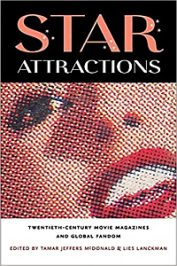Ever since motion pictures became a crucial part of popular culture, certain consumers decided that simply watching those products and going to the theaters was not enough. Accordingly, editors of the earliest movie magazines quickly realized that gossip, behind-the-scenes talk and all sorts or rumors surrounding those new media stars obviously were at least as interesting to (the mostly female) readers as the actual movie plots, their settings or box office sales. Hence, the movie fan magazine was born.
 Already in the late 1920s, several titles were available at the newsstands in the US, Asia, Europa and Latin America; interestingly, those publications also had an inevitable social and communicative/interactive potential, as readers were encouraged to enter in competitions, and write letters to the editors. Usually, the best published fan letters were awarded monetary prizes ranging from $5 to $20 (in 1930).
Already in the late 1920s, several titles were available at the newsstands in the US, Asia, Europa and Latin America; interestingly, those publications also had an inevitable social and communicative/interactive potential, as readers were encouraged to enter in competitions, and write letters to the editors. Usually, the best published fan letters were awarded monetary prizes ranging from $5 to $20 (in 1930).
Many types of the fan magazine are under discussion here, beginning with the initial American title Motion Picture Story Magazine (first printed in 1911). Proceeds of the various magazines differed widely, with certain periodicals easily selling more than 1,000,000 copies per month.
McDonald and Lanckman see the importance of the early fan magazine in connection with film studies as a major source of information, offering tremendous amounts of data, information on contemporary tastes and not to be neglected historical documents shaping popular culture. Only in the last few years have fan magazine become more important to Film Studies and New Cinema History; before that, this media was usually not really recognized, due to the large number of publications there dealing with either scandal, pure gossip, alleged fact and very often plain nonsense and falsehood.
Being able to utilize massive amounts of “new old sources” – recently digitized large periodical collections from all over the world, provided by the Media History Digital Library – fresh research was possible, which would give data on fan behavior and would lead to novel fields of study. The editors accordingly state that the authors of this collection treat “… these magazines not as secondary research objects – to be read in search for objective truth about stars and films – but as primary sources…”
With those sources,the texts aim to answer certain questions, typical for the study of fandom culture: “how and why these artifacts were created, how to read them, and to interpret them. … Our chapters treat the magazines not as sources of spurious information, but instead as conduits of historical assumptions: assumptions about appropriate gender roles, goals, behavior, desires, and appearance, via the stars and movies whose promotion formed the center of every issue, as well as other consumables such as clothes, items of personal hygiene, grooming, and household improvement the surrounded and contextualized the filmic elements.”
Contrary to the bulk of the studies on media culture and fan participation (focusing on the ages of television and video games), the emphasis of the book here is on roughly the time from the 1920s to the 1960s, with entirely different means of communication and involvement at work and naturally, distinctive mindsets, gender roles, models of success and other expectations.
The twelve chapters feature very diverse topics such as media depictions of actress and producer Alla Nazimova, stardom in Malay Cinema, Romanian film magazine(s), spectatorship in Postwar France, British Elvis Fandom in the 1960s and other subjects. Two texts deserve particular attention, namely a good text on Mae West and one on the search of lost fans, for instance, the politics of fan letters treatment.
In addition to the two editors, the list of contributors include Alissa Clarke, Ann-Marie Fleming, Geneviève Sellier, Emily Chow-Kambitsch, Michael Williams and others.
Star Attractions is an intriguing addition for students and fans of early cinema, fandom culture, media statistics and social aspects of film promotions.
Review by Dr. A. Ebert © 2020
Tamar Jeffers McDonald and Lies Lanckman (eds.) Star Attractions: Twentieth-Century Movie Magazines and Global Fandom. (Fandom & Culture Series) University of Iowa Press, 2019, 282 p.
